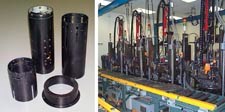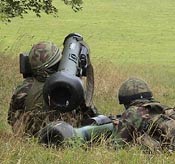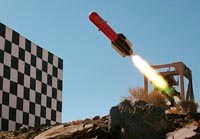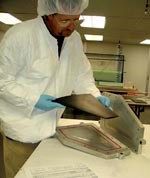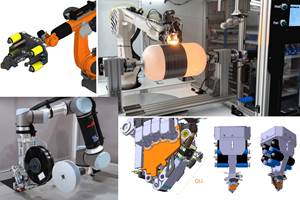Composites target tactical missiles
Composite benefits are surmounting obstacles in manufacture of small, high-volume missile systems.
Since the German V-1 "flying bomb" of World War II, hundreds of military missile systems have been developed. This aerospace segment includes any self-propelled projectiles that carry weapons or other military payloads. Today, missiles vary from shoulder-fired missiles (about 50 cm/20 inches long and 6 cm/2.5 inches in diameter with a range of 1,000m/3,300 ft) to intercontinental ballistic missiles as long as 18m/60 ft and 1.7m/5.5 ft in diameter, with ranges greater than 5,500 km/3,418 miles. Capabilities range from "dumb" systems that simply follow their ballistic trajectory to "fire-and-forget" missiles -- self-guided systems that ensure an accurate strike without human guidance.
Tactical missiles are offensive, in-theater combat vehicles -- the smallest, most prolifically manufactured, but least hospitable to composites of four military missile types. The other three are generally larger systems: (1) launch vehicles for military space payloads, (2) long-range strategic missiles for offensive deterrence, and (3) defensive missiles used to intercept incoming missiles. While all missile systems are trending toward greater use of composites, composite utility can vary significantly, based on missile size and mission requirements. Some composite properties serve all categories well. High strength and stiffness, for instance, handle the tremendous aerodynamic loadings -- about 1,465 kg/m2 (300 lb/ft2) for a tactical missile, for example, compared to under 488 kg/m2 (100 lb/ft2) for an unmanned aerial vehicle (UAV). Temperature requirements, on the other hand, differ for long-range and short-range missiles, explains Don Uhlir, technical director for Raytheon Missile Systems (Tucson, Ariz.). "For fast, short flights, high temperatures will only be experienced at the surface, so components will experience a large temperature gradient," he notes. The surface temperature may actually rise above the glass-transition temperature of the matrix (Tg). "The hardest part is getting property data with such a gradient," he adds. Such data is easier to gather for homogenous metals than composites. On longer flights, materials reach an equilibrium temperature, which more directly challenges the material's high-temperature performance.
Other factors are the result not of missile flight but severe loads imposed on missiles mounted on carrier-based naval aircraft, when the flight deck catapults (called "cats") help launch the planes and tailhook-and-tether trapping mechanisms (called "traps") halt the aircraft during landings. "Sometimes these cat and trap loads are most critical," Uhlir notes. "Or captive carry (the amount of flight hours) could make fatigue life a driving factor." For aircraft-mounted missiles, Uhlir points out, "the biggest challenge is that we have to fit within a predetermined volumetric box."
For the tactical missile manufacturer, the superior strength-to-weight ratio of composites has made them the material of choice for a modestly growing number of aerodynamic surfaces and structural components in missiles. But two other factors are beginning to drive additional research and development: First, composites are now cost-competitive with metals. "When we specified composites ten years ago, we accepted a cost premium because of the weight savings we could achieve," says Steven Barnoske, Joint Common Missile (JCM) program director at Lockheed Martin Missiles and Fire Control (Orlando, Fla.). "But recently, we looked at metal alternatives and found that the cost is not very different." Second, but most important, according to Barnoske, is composites' performance under fire.
Insensitive munitions
Under a mandate from the U.S. Department of Defense (DoD), the U.S. Army began its Insensitive Munitions (IM) program in 1987 to "adopt gradually an inventory of the world's most lethal ground force munitions that perform as they are intended but are less prone to violent reaction when subjected to impact from bullets and fragments, heat from fire, and shock from neighboring explosions," Kendal Duncan observed in the Army Logistician bulletin (January/February 2002 p. 16-17). An explosives logistics specialist in the Logistics Research and Development Activity of the Army Tank-automotive and Armaments Command Armament Research, Development and Engineering Center (Picatinny Arsenal, N.J.), Duncan noted that other DoD branches have followed suit. Given the threat of terrorist activity, for example, there is a drive to keep missiles from exploding if damaged by a saboteur's explosive device or unfriendly fire during transport or storage. "Without safe, survivable ammunition and missiles," says Duncan, "we risk losing our warfighting assets during deployment and distribution, as well as in combat." IM programs have advanced the chemistry of propellants and explosives as well as launch and targeting mechanisms that help gunners escape enemy detection. Relevant to composite missile components are recent IM program requirements for safe release of propellants and explosives when the missile body is breached.
The "insensitive munitions" drive has been a motivating force in Lockheed Martin's development of the JCM, a new, extended-range, advanced air-to-ground missile system that will replace Hellfire, Longbow and Maverick systems. During competition for the 177.5-cm/69.9-inch long, 17.8-cm/7-inch diameter JCM, Lockheed Martin "deferred the composite design work," Barnoske reports. "We didn't need to meet weight and affordability targets in this phase." There was, however, one conspicuous exception: The rocket motor, which must operate successfully in the temperature extremes it will experience, in both rotary- and fixed-wing aircraft, and deliver maximum range from all required aircraft platforms. Because the design of its casing is critical to the missile's insensitive muni-tions status, the casing was conceived as a composite construction from the outset, Barnoske says.
As a result of work done under its own company-funded, pre-contract risk reduction initiative, Lockheed has specified the JCM's composite rocket motor casing, which is filament wound by Aerojet (Sacra-mento, Calif.). If an improv- ised explosive device or other munition impacts the missile, the pressurization and failure characteristics of the filament wound casing allow propellant to escape and burn in a more controlled fashion, which minimizes collateral damage. Specifically, composites demonstrate a leak-before-burst characteristic that allows pressurized composite containers to depressurize less rapidly, rather than rupture catastrophically, as would be likely with a metal casing.
The JCM program is now the beneficiary of a $53 million system design and development (SDD) contract, awarded in May 2004, which includes a 14-month risk reduction phase followed by a 36-month testing/integration phase. As part of the SSD, Lockheed is investing intensively in the previously deferred area of composite design. A contract with SPARTA Composites (San Diego, Calif.) is funding a trade study of two structures, the cylinder-and-dome-shaped "seeker" housing (the missile guidance system enclosure) and the cylindrical warhead housing. Converted to composites, these components will weigh 25 to 30 percent less, predicts SPARTA engineering manager Joe Cook. For the trade study, the company has conducted detailed analyses, using MSC.NASTRAN software from MSC.Software Corp. (Santa Ana, Calif.), to address the objective of reducing weight while meeting strength and stiffness requirements. Achieving this objective was a challenge, especially since SPARTA needed to maintain JCM's current configuration, using the same envelope and fasteners, for example, as specified in the initial design. Some part consolidation has been investigated, Cook adds, including molded-in standoffs and lugs.
Ultimately, Lockheed Martin has identified eight components that will migrate to composites, including the missile's fins; housings for the control actuation systems, warhead and guidance electronics; and a bulkhead in the seeker. The lighter weight of these composite components will contribute to the extended range capabilities of the JCM -- 16 km/10 miles when launched from rotorcraft and 28 km/17.5 miles from fixed-wing aircraft. More significantly, Barnoske points out, the lower weight will improve the carrying capacity of the aircraft. "The Apache helicopter, for example, can carry 16 of these," he notes. "So in fully loaded conditions, any deltas in weight multiply by 16." Lower payload weight means more fuel capacity and, thus, greater range for the aircraft.
The JCM missile will benefit a broad range of U.S. Army, Navy and Marine Corps programs through its use of composites. In total, the three military branches are expected to procure as many as 54,000 JCM rounds to replace the Longbow/Hellfire missiles on the Apache, Cobra and Strikehawk helicopters and the Maverick missile on the F/A-18 Hornet jet fighter. After design and development at Lockheed Martin's Orlando facility, the missiles will be produced at the company's advanced missile manufacturing facility in Troy, Ala. JCM will be deployed for an anticipated two decades, beginning in 2010, at a total lifetime contract value of about $5 billion. The United Kingdom's Ministry of Defence has expressed interest in possible JCM co-development and co-production.
Automating fabrication
SPARTA Composites also has been tapped to build components for the JAVELIN antitank weapon system, produced under a joint venture of Raytheon Missile Systems (Tucson, Ariz.) and Lockheed Martin. Designed to be carried and operated by a single soldier or marine, the JAVELIN is a medium-range (up to 2,500m/2,734 yd) fire-and-forget missile that proved itself in major combat operations in Iraq and Afghanistan. Each missile weighs 11.8 kg/26.1 lb and is 108.1 cm/42.6 inches long and 12.7 cm/5 inches in diameter. JAVELIN was first fielded by the Army and Marines in 1996, and 20,000 have been ordered to date. Nine additional countries have selected JAVELIN for their armed forces.
To achieve the weight requirements for one-man portability, including a total system weight not exceeding 22.5 kg/49.5 lb, the JAVELIN relies on four major composite components built by SPARTA Composites. (Early design studies with aluminum parts failed to meet the weight requirement.) Beginning with the engineering and manufacturing development (EMD) phase of the JAVELIN program and continuing into full-rate production, SPARTA Composites has been building the guidance electronic unit, mid-body housing, control actuator skin and aft bearing ring, all cylindrical components with critical cutouts and features. Integrally heated, all-metal closed molds for these components include inner and outer mold details for net molding of inner and outer diameters, length, wing slots, attachment holes and other features.
The combination of affordability requirements, relatively high production rates (400 parts per week) and tight tolerance requirements -- a diameter within ±0.002 inch, wall thickness within ±0.003 inch, molded-in features within ±0.004 inch -- challenged SPARTA Composites to automate its "net compression molding" process. The process cures prepreg layups under pressure within molds that close to positive stop positions, to yield net-shape inner and outer diameters.
To produce the initial EMD-phase units, patterns were cut in the prepreg primarily by hand, and layup was performed with the mold positioned on a "lazy susan" (manually operated turntable). Penetration features, such as wing slots, were hand punched in the layup prior to cure. Tools were closed by hand, and only the cure cycle was automated, via programmable temp-erature controllers.
This labor-intensive approach demanded highly skilled technicians to perform the fabrication. The company would have incurred high production costs had it attempted to ramp up to full production rate with this approach, SPARTA Composites' Cook notes, pointing to not only labor costs but also the cost of cleaning and releasing the complex tools, the excessive wear on hand-operated punches and the high scrap rate inherent to manual processes.
Advancements implemented during low-rate initial production addressed many of these shortcomings. Steel-rule dies were created to stamp 95 percent of the ply patterns. New layup stations employed indexed, motor-driven chucks in place of of lazy susans. This shop aid could be turned in both directions, which facilitated debulking with shrink tape. Automatic mold closers eliminated manual closing through multiple bolts, and a PC took over control of temperature and pressure and also handled data logging. A demolding machine mecha-nized mold disassembly and part removal. And dedicated, high-spindle speed, numerically controlled four-axis milling machines replaced the hand punches for penetration features, simultaneously increasing cost-efficiency and decreasing part-to-part variation.
As SPARTA Composites has transitioned into full-rate production, additional automation has yielded a four-fold increase in production rates, with no increase in scrap rate. Layup carts now offer variable positioning for different tasks, integrated hands-free operation for layup, and vacuum (rather than shrink-tape) debulking. Second-generation mold closing machines feature analog hydraulics for pressure control. Process control has improved with the addition of a PLC controller at each station. Instrumentation and power connections are now auto-mated, and motorized conveyors as well as improved cranes have advanced the tool handling system. To date, SPARTA Composites has delivered more than 136,000 parts, on time and with a scrap rate well under 5 percent.
Tactical inertia
JCM and JAVELIN are not mere radar glitches. Many other tactical missile programs are the subjects of internal research and development (IR&D) efforts to advance missile performance through material selection. Despite the great potential these programs imply, many missile system program offices, especially for existing missile systems, have yet to signal interest in moving form IR&D to implementation in production.
A case in point is the AIM-120 Advanced Medium-Range Air-to-Air Missile (AMRAAM), first deployed in 1991 and expected to continue service beyond 2020. Prime contractor Raytheon has delivered more than 11,000 of these self-guided "launch and leave" missiles to the U.S. Air Force and Navy as well as more than 25 U.S. allies. Current projections call for another 14,000 (both air-to-air and surface-launched versions) in the next 15 years. The 162 kg/356 lb, 3.7m/12-ft long, 18-cm/7-inch diameter missile has performed successfully in Bosnia, Kosovo and Iraq. Now entering its fifth generation of upgrades, AMRAAM still uses only a "very small amount" of composites, says Uhlir. No significant material changes have been made since the program's inception.
Raytheon, however, continually investigates different materials and processes, says Uhlir. In one project, V System Composites (Tucson, Ariz.) is doing preliminary design, analysis and fabrication of four deliverable composite wings for the AMRAAM. By switching from the current titanium wings, Raytheon could reduce wing weight by 50 percent and increase the missile's range, reports Steve Slocum, manager of V System's Tucson operation. The wing features a trapezoidal planform and measures about 30 cm/12 inches from leading to trailing edge, at the base, with a 13-cm/5-inch span. While the wing base is about 7 mm/0.300-inch thick, its sharp edge has a radius of only 1.5-mm/0.060-inch -- quite a challenge for a composites manufacturer. "Damage tolerance is a problem if we get resin-rich areas at the edges," admits Slocum. V System is molding the parts via resin transfer molding (RTM), in anticipation of the necessarily high part rate the company will have to maintain should the wing move into production of as many as 10,000 units. A closed mold is needed, in any case, to meet the tight tolerances, Slocum notes. Production composite wings also would require some metal or ceramic shielding on the leading edges, because the missile's running temperature is hotter than polymer matrices can withstand.
But the more significant task for V System might be to make accurate property predictions. The company is producing panels on which to conduct coupon tests for design allowables. These allowables will be plugged into the finite element analysis (FEA) model to predict failure loading. Raytheon will be able to compare the predicted loading to actual loading, when it tests the delivered wings to failure -- all in an effort to show that composite struc-tures can be reliably designed.
In addition to weight savings, composites appeal to missile builders in areas where they offer special features, Uhlir notes, such as radomes and secondary structures with complex shapes and significant aeroloading. Further, he believes that composites will move into specialized applications, as designers exploit the ability to inhibit flutter through aeroelastic tailoring (varying stiffness and strength properties directionally) or active damping systems. "If it's stiff only when you need it stiff, that reduces the mass you have to carry," Uhlir says.
Raytheon also has a fairly large IR&D program looking at high-temperature resins that offer a Tg above the missile's worst-case operating temperature. And in a futuristic area of research, the company is exploring adaptable designs, in which actuators, such as shape-memory alloy wires, could be imbedded within the com-posite plies, enabling missile designers to adapt the in-flight aerodynamics by changing the shape of control surfaces, such as wings. The latter, Uhlir notes, is nearly impossible with metals.
Obstacles to greater employment of composites remain, says Uhlir. The foremost is the cost of tooling. "Tooling costs for composites are dropping, but casting and forging costs for metal are dropping, too," Uhlir reports. "Other suppliers are not going to roll over." Although parts consolidation often offsets tooling cost in other composites applications, one-piece outer casings are frequently impractical for small missile assembly and maintenance. And Uhlir echoes others' concerns about the damage-tolerance of sharp leading edges. Further, builders of missile systems, like aircraft manu-facturers, must factor significant requalification costs into their equations -- not only qualification of the missile itself, but qualification on every aircraft that will carry it, as well.
While these obstacles are not insurmountable, Uhlir points out, "Cost is key. If we can eke out a little cost improvement in a large-volume pro-gram, it's worth looking at requal- ifying." For that reason, Raytheon continues to look at products from many vendors to see what innovations may be on offer. "We strive to work with the best," he says. The future growth of composites use in tactical missiles, therefore, will no doubt depend heavily on the ingenuity of composites fabricators and their suppliers.
Related Content
Manufacturing the MFFD thermoplastic composite fuselage
Demonstrator’s upper, lower shells and assembly prove materials and new processes for lighter, cheaper and more sustainable high-rate future aircraft.
Read MoreA new era for ceramic matrix composites
CMC is expanding, with new fiber production in Europe, faster processes and higher temperature materials enabling applications for industry, hypersonics and New Space.
Read MoreThe next evolution in AFP
Automated fiber placement develops into more compact, flexible, modular and digitized systems with multi-material and process capabilities.
Read MorePEEK vs. PEKK vs. PAEK and continuous compression molding
Suppliers of thermoplastics and carbon fiber chime in regarding PEEK vs. PEKK, and now PAEK, as well as in-situ consolidation — the supply chain for thermoplastic tape composites continues to evolve.
Read MoreRead Next
VIDEO: High-volume processing for fiberglass components
Cannon Ergos, a company specializing in high-ton presses and equipment for composites fabrication and plastics processing, displayed automotive and industrial components at CAMX 2024.
Read MoreAll-recycled, needle-punched nonwoven CFRP slashes carbon footprint of Formula 2 seat
Dallara and Tenowo collaborate to produce a race-ready Formula 2 seat using recycled carbon fiber, reducing CO2 emissions by 97.5% compared to virgin materials.
Read MoreDeveloping bonded composite repair for ships, offshore units
Bureau Veritas and industry partners issue guidelines and pave the way for certification via StrengthBond Offshore project.
Read More




